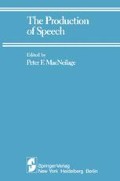Abstract
In many of the Indo-European languages (Öhman, 1967; Isačenko & Schädlich, 1966;’t Hart, 1966; Maeda, 1974; Vaissière-Maeda, 1980) as well as in the Japanese language (Fujisaki & Nagashima, 1969), the contour of the voice fundamental frequency (henceforth F 0 contour) plays an important role in transmitting not only linguistic information but also nonlinguistic information such as naturalness, emotion, and speaker idiosyncrasy. Because of difficulties in accurate analysis and in quantitative description, the relationships between the linguistic-nonlinguistic information and the F 0 -contour characteristics have not been fully clarified. The elucidation of these relationships requires, first, the selection of characteristic parameters that are capable of describing the essential features of an F 0 contour, and second, a method for extracting these parameters from an observed F 0 contour. In other words, an analytical formulation (i.e., a model) of the control process of voice fundamental frequency is indispensable for the quantitative analysis and linguistic interpretation of F 0 -contour characteristics.
Access this chapter
Tax calculation will be finalised at checkout
Purchases are for personal use only
Preview
Unable to display preview. Download preview PDF.
References
Buchthal, F., & Kaiser, E. Factors determining tension development in skeletal muscle. Acta Physiologica Scandinavica, 1944, 8, 38–74.
Fujisaki, H., & Nagashima, S. A model for synthesis of pitch contours of connected speech. Annual Report, Engineering Research Institute (University of Tokyo), 1969, 28, 53–60.
Fujisaki, H., & Sudo, H. A model for the generation of fundamental frequency contours of Japanese word accent. Journal of the Acoustical Society of Japan, 1971, 27, 445–453.(a)
Fujisaki, H., & Sudo, H. Synthesis by rule of prosodic features of connected Japanese. Proceedings of the 7th International Congress of Acoustics, 1971, 3, 133–136.(b)
Fujisaki, H., & Sudo, H. A generative model for the prosody of connected speech in Japanese. Conference Record, 1972 Conference on Speech Communication and Processing, IEEE-AFCRL, 1972, 140–143.
Fujisaki, H., & Sugito, M. Analysis and perception of two-mora word accent types in the Kinki dialect. Journal of the Acoustical Society of Japan, 1978, 34, 167–176.
Hirose, K., & Fujisaki, H. Acoustical features of fundamental frequency contours of Japanese sentences. Proceedings of the 10th ICA, 1980, 2, AL-9.2.
Hirose, K., Fujisaki, H., & Sugito, M. Acoustic correlates of word accent in English and Japanese. Transactions of the Committee on Speech Research, Acoustical Society of Japan, 1978, S78–41.
Isačenko, A. V., & Schädlich, H. J. Untersuchungen über die deutsche Satzintonation. Studia Grammatica, 1966, 7, 7–67.
Maeda, S. A characterization of fundamental frequency contours of speech. Quarterly Progress Report, Research Laboratory of Electronics, MIT, 1974, 114, 193–211.
Ohala, J., & Ewan, W. Speed of pitch change. Journal of the Acoustical Society of America, 1973, 53, 345(A).
Öhman, S. Word and sentence intonation: A quantitative model. Speech Transmission Laboratory Quarterly Progress and Status Report (Stockholm), 1967, 2–3, 20–54.
Sandow, A. A theory of active state mechanisms in isometric muscular contraction. Science, 1958, 127, 760–762.
Slater, J. C., & Frank, N. H. Introduction to theoretical physics. New York: McGraw-Hill, 1933.
Sundberg, J. Maximum speed of pitch changes in singers and untrained subjects. Journal of Phonetics, 1979, 7, 71–79.
‘t Hart, J. Perceptual analysis of Dutch intonation features. I. P. O. Annual Progress Report, 1966, 1, 47–51.
Vaissière-Maeda, J. La structuration acoustique de la phrase française. Annali della Scuola Normale Superiore di Pisa (Ser. III), 1980, 10(2), 529–560.
Editor information
Editors and Affiliations
Rights and permissions
Copyright information
© 1983 Springer-Verlag New York Inc.
About this chapter
Cite this chapter
Fujisaki, H. (1983). Dynamic Characteristics of Voice Fundamental Frequency in Speech and Singing. In: MacNeilage, P.F. (eds) The Production of Speech. Springer, New York, NY. https://doi.org/10.1007/978-1-4613-8202-7_3
Download citation
DOI: https://doi.org/10.1007/978-1-4613-8202-7_3
Publisher Name: Springer, New York, NY
Print ISBN: 978-1-4613-8204-1
Online ISBN: 978-1-4613-8202-7
eBook Packages: Springer Book Archive

